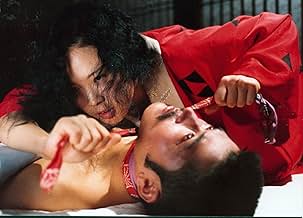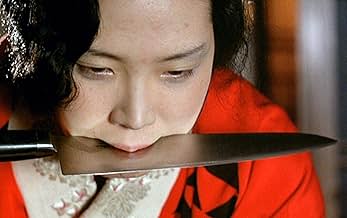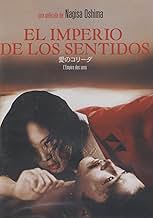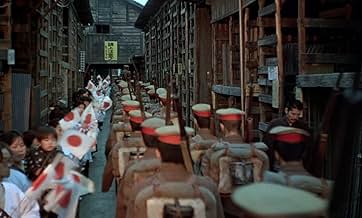Eine leidenschaftliche Erzählung der Geschichte von Sada Abe, einer Frau, deren Affäre mit ihrem Meister zu einer sexuellen Obsession führte, die dann ein gewaltsames Ende fand.Eine leidenschaftliche Erzählung der Geschichte von Sada Abe, einer Frau, deren Affäre mit ihrem Meister zu einer sexuellen Obsession führte, die dann ein gewaltsames Ende fand.Eine leidenschaftliche Erzählung der Geschichte von Sada Abe, einer Frau, deren Affäre mit ihrem Meister zu einer sexuellen Obsession führte, die dann ein gewaltsames Ende fand.
- Regie
- Drehbuch
- Hauptbesetzung
- Auszeichnungen
- 4 wins total
Empfohlene Bewertungen
With his landmark film The Ceremony, Nagisa Oshima became one of Japanese filmdom's leading social critics as he dissected the logic behind ritual suicide, arranged marriages and other activities considered acceptable 'traditional' behavior. Here he examines the story behind a famous Japanese scandal - a prostitute was found wandering the streets of Tokyo out of her mind following the death of her lover by erotic asphyxiation - in terms of what is considered 'acceptable' Japanese social behavior. The principals engage in obsessive sexual activity, and allow the addictive and dangerous aspects of their relationship to get out of hand precisely BECAUSE it was considered so unhealthy and immoral by Japanese standards. In a society in which all sexual activity is viewed as shameful, shame no longer mediates behavior. Limits become meaningless. The film itself is colorfully made, with excellent period detail and production design, and the actors are attractive. The structure is that of an erotic novel, as game playing, obsession and danger escalate to a fitting point-of-no-return climax. It is much better and more socially relevant than similar American films such as Nine 1/2 Weeks.
It's clear that a lot of people can't get past the explicitness of this film, which is a shame. I recall a lot of embarrassed giggling last time I saw it at the cinema. The art/pornography debate seems futile to me - this is a film about an obsessive sexual relationship/love affair and it tells it like it is. But it's about as far away from the likes of "Debbie Does Dallas 26" as you can get. The film is clearly serious in intent and there is a lot of beauty in it.
The subtle political content/context of the film is often overlooked - some of the few scenes shot outside the bedroom show groups of soldiers marching the other way from the direction our characters travel - and we all know where the rising Japanese militarism and nationalism of the 1930's led.
I think the best comparison is probably with a film like "Last Tango in Paris" which dealt with similar themes in a similar way - and was probably also pretty boring for those with a short attention span.
The subtle political content/context of the film is often overlooked - some of the few scenes shot outside the bedroom show groups of soldiers marching the other way from the direction our characters travel - and we all know where the rising Japanese militarism and nationalism of the 1930's led.
I think the best comparison is probably with a film like "Last Tango in Paris" which dealt with similar themes in a similar way - and was probably also pretty boring for those with a short attention span.
Nagisa Oshima has achieved what few other directors have managed in dealing with the very touchy subject of sex, in this instance, with sexual obsession. If you plan to watch this movie for a cheap sexual thrill, you will be most disappointed. Oshima has drawn from a real incident reported in a 1936 Japanese newspaper. The film centers around the love between two people expressed physically, graphically, into realms of the senses where few dare to tread. And with good reason. This is a very intense film as it progresses from the attraction of two people through increasing experimentation in an effort not only to express their passion but to try to find the outer most limits of passion itself. Oshima must have had something metaphorical in mind but the journey as chronicled in the film also has retained the feel of the specifics. It's quirkey and eccentric. The backdrop of the story is as interesting as the story itself. It is an amazing spectacle to observe, giving the viewer a perspective on Japanese life not usually rendered but often alluded to in some historical accounts. One wonders what this experience must have been like for the actors. Oshima has managed what I have always believed should be done in order to treat the subject of sex fully and without shrinking from its' less savory aspects. This is serious minded erotica and quite unlike anything else on screen. The only other film I can recall that compares at all is "Taxi Zum Klo" which was autobiographical and starred a number of actual people playing themselves.Obviously a different catagory in that regard from what is going on here, but both films draw much of their power from explicitly sexual scenes without compromising the integrity of the story being told. This is a film experience that should not be missed.
I wrote a review of this film 15 years ago in which I claimed it was quite sophisticated. It was found helpful by 71 out of 89 people on this site. How naive I was, and, I must admit, pretentious. I am a good deal wiser now and I see the film in a completely different light. Now all I see is subversion and misogyny. Specifically it is a desperate effort to subvert conventional society by depicting heterosexual sex as baleful and destructive. Why would the director want to do such a thing? Think about it. It won't take more than a few seconds.
This kind of thing obviously used to pass for art. Not any more.
March 2019
I saw this film the first time in the movies in holland about 78; I was sitting next to a nice girl wiht her boyfriend and felt terribly upset. I knew this was very real. Not romantic at all. It shows what sex can do to people and although in the ending the dramatics are overdone to my taste; this is a classical tragedy. The acting is incredible; i think the one big problem making movies showing real sex that the actors can't cope with it. These actors could. Everybody who can't see through the pornografic explicities is sexually unfree and morally limited. This film isn't a happy one and doesn't show us the freedom that sex can bring us; it shows the slavery which sex can bring about; it's problably the best film ever about sex addiction there is. It's a problem that is hardly publicly debated; or if in the hands of Christian crusaders, who want to take us all the fun. In other critics you read about th Art question : "is this Art?" Not an important question, but for me it is; it has learnt me very much about the human condition and how we cope with it.
Wusstest du schon
- WissenswertesDemand to see the film at its first appearance at the Cannes Film Festival was so high, 13 screenings were arranged.
- Alternative VersionenThe original version ran 108 minutes. Producer Anatole Dauman received Oshima's permission to recut the film, resulting in a shorter 102-minute edit. This version has been distributed theatrically in some countries (such as France) and is available on video in Australia, the UK, the United States, and France. The French DVD includes both versions (via seamless branching), while the U.S. Criterion DVD features the cut footage as an extra. The PAL releases run 97 minutes. This shorter version makes the following changes:
- An early scene in which Sada has sex with Ishida while playing a shamisen has been cut by about a minute and a half. In the original version, Sada seemingly goes unconscious and Ishida checks for her heartbeat.
- A brief shot (12 seconds) of Ishida and Sada on a bridge has been added to the scene in which the couple goes out walking at night.
- A later scene (in which the geishas assault one of their own with a dildo) is cut by 14 seconds to remove a shot of Ishida and Sada's faces in mid-copulation.
- An entire two-minute scene is deleted about an hour into the film. This scene features Sada and Ishida having sex behind a thin screen, while Ishida speaks of the "darkness" he feels inside Sada.
- The scene in which Sada first strangles Ishida is cut by just over one minute. In the short version, the scene ends when Ishida starts coughing and Sada releases his throat. In the original version, Ishida asks her to resume, which she does (only to stop when he begins coughing again).
- The scene in which Ishida becomes drowsy while having sex with Sada is edited differently. The original version has slightly different dialogue and has an additional minute of footage where Ishida actually does fall asleep for a short time.
- The scene in which Sada wakes up after her final night with Ishida is cut by one minute. The original version shows Sada lying on the floor and apparently panicking, walking around the room and opening doors for no obvious reason. The short version cuts straight from Sada waking up to the shot of her standing over Ishida's body.
- VerbindungenEdited into Video Macumba (1991)
- SoundtracksBallades for koto II-Spring: Mebae (Seeding)
Composed by Minoru Miki
Top-Auswahl
Melde dich zum Bewerten an und greife auf die Watchlist für personalisierte Empfehlungen zu.
- How long is In the Realm of the Senses?Powered by Alexa
- Is this film still banned in Japan?
- Are the actors having real sex?
- What are the differences between the old BBFC 18 Version and the Uncensored Version?
Details
- Erscheinungsdatum
- Herkunftsländer
- Offizieller Standort
- Sprache
- Auch bekannt als
- El imperio de los sentidos
- Drehorte
- Produktionsfirmen
- Weitere beteiligte Unternehmen bei IMDbPro anzeigen
Box Office
- Weltweiter Bruttoertrag
- 569 $
- Laufzeit1 Stunde 49 Minuten
- Seitenverhältnis
- 1.37 : 1
Zu dieser Seite beitragen
Bearbeitung vorschlagen oder fehlenden Inhalt hinzufügen




























